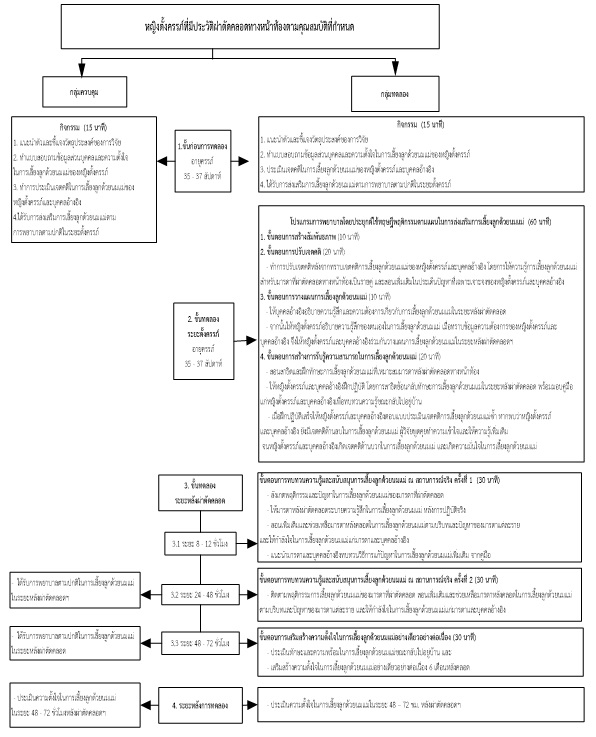ผลของโปรเเกรมการพยาบาลโดยประยุกต์ใช้ทฤษฎีพฤติกรรมตามแผน ต่อความตั้งใจในการเลี้ยงลูกด้วยนมแม่ของมารดาที่ผ่าตัดคลอดทางหน้าท้อง
คำสำคัญ:
มารดาที่ผ่าตัดคลอดทางหน้าท้อง, ความตั้งใจในการเลี้ยงลูกด้วยนมแม่, ทฤษฎีพฤติกรรมตามแผนบทคัดย่อ
การวิจัยกึ่งทดลองนี้มีวัตถุประสงค์เพื่อศึกษาผลของโปรเเกรมการพยาบาลโดยประยุกต์ใช้ทฤษฎีพฤติกรรมตามแผนต่อความตั้งใจในการเลี้ยงลูกด้วยนมเเม่ของมารดาที่ผ่าตัดคลอดทางหน้าท้องขณะอยู่โรงพยาบาล กลุ่มตัวอย่างเป็นหญิงตั้งครรภ์ที่มาฝากครรภ์ ณ แผนกฝากครรภ์และเข้ารักษาต่อเนื่องในระยะหลังผ่าตัดคลอดทางหน้าท้อง ณ แผนกสูติกรรมโรงพยาบาลทั่วไปแห่งหนึ่งของภาคใต้ เลือกตามคุณสมบัติที่กำหนด จำนวน 50 ราย แบ่งเป็น กลุ่มควบคุมและกลุ่มทดลอง กลุ่มละ 25 ราย เครื่องมือที่ใช้ในการวิจัย ประกอบด้วย 1) เครื่องมือที่ใช้ในการดำเนินการทดลอง ได้แก่ โปรแกรมการพยาบาลโดยประยุกต์ใช้ทฤษฎีพฤติกรรมตามแผน สื่อภาพพลิก และคู่มือการเลี้ยงลูกด้วยนมแม่สำหรับมารดาที่ผ่าตัดคลอดทางหน้าท้อง 2) เครื่องมือที่ใช้ในการกำกับการทดลอง ได้แก่ แบบประเมินเจตคติการเลี้ยงลูกด้วยนมแม่ของมารดาที่ผ่าตัดคลอดทางหน้าท้อง และของบุคคลอ้างอิง 3) เครื่องมือในการเก็บรวบรวมข้อมูลได้แก่ แบบสอบถามข้อมูลส่วนบุคคล และแบบประเมินความตั้งใจในการเลี้ยงลูกด้วยนมแม่ของมารดาที่ผ่าตัดคลอดทางหน้าท้อง วิเคราะห์ข้อมูลโดยใช้สถิติทีคู่และสถิติทีอิสระ ผลวิจัยพบว่า
1. มารดาหลังผ่าตัดคลอดทางหน้าท้องกลุ่มทดลองที่ได้รับโปรเเกรมฯ มีคะแนนเฉลี่ยความตั้งใจในการเลี้ยงลูกด้วยนมแม่หลังได้รับโปรแกรม (M=52.16, SD=3.51) สูงกว่าก่อนได้รับโปรเเกรม (M=42.24, SD=4.64) อย่างมีนัยสำคัญทางสถิติ (t=3.50, p<.01)
2. มารดาหลังผ่าตัดคลอดทางหน้าท้องกลุ่มทดลองที่ได้รับโปรแกรมฯ มีคะแนนความตั้งใจในการเลี้ยงลูกด้วยนมแม่ (M=52.16, SD=3.51) สูงกว่ากลุ่มควบคุม ที่ได้รับการพยาบาลตามปกติ (M=49.64, SD=4.72) อย่างมีนัยสำคัญทางสถิติ (t=2.14, p<.05)
โปรแกรมการพยาบาลโดยประยุกต์ใช้ทฤษฎีพฤติกรรมตามแผน สามารถใช้เป็นแนวทางการส่งเสริมความตั้งใจในการเลี้ยงลูกด้วยนมแม่ของมารดากลุ่มผ่าตัดคลอดทางหน้าท้องและการนำครอบครัวเข้ามามีส่วนร่วม และสามารถใช้เป็นแนวทางเพื่อการวางแผนการเลี้ยงลูกด้วยนมแม่ของมารดาที่ผ่าตัดคลอดทางหน้าท้องให้สำเร็จตั้งแต่ระยะตั้งครรภ์ ระยะแรกเริ่มหลังคลอด และการเลี้ยงลูกด้วยนมแม่อย่างเดียวอย่างต่อเนื่องจนถึง 6 เดือนหลังคลอด
เอกสารอ้างอิง
Ajzen, I. (1991). The Theory of Planned Behavior. Organizational Behavior and Human Decision Processes, 50(2), 179-211.
Baimonta, L., Nirattharadorn, M., & Kamolwarin, S. (2015). The Effect of Promoting Breast Feeding Program on Maternal Breastfeeding and Milk Flow among Women Experiencing Cesarean Section. Nursing Journal, 42(4), 65-75. (in Thai).
Budsaengdee, B., Kantaruks, K., & Chareonsanti, J. (2013). Effects of Self-Effiicacy Promotion on Success in Exclusive Breastfeeding among Cesarean Section Mothers. Nursing Journal, 40(3), 1-10. (in Thai).
Cohen, J. (1988). Statistical Power Analysis for the Behavioral Sciences (2nd ed.). Hillsdale, NJ: Lawrence Erlbaum Associates, Publishers.
Danthes, D. (2016). Effects of Breastfeeding Promoting Program for Working Pregnant Women on Attitude and Intention to Exclusive Breastfeeding. A Dissertation Submitted in Partial Fulfillment of the Requirement for the Master Degree in Faculty of Nursing Burapha University. (in Thai).
Ding, T. T., & Luo, B. R. (2019). Effect of Individualized Intervention on Postpartum Breast-Feeding Behavior After Cesarean Section. Journal of Sichuan University. Medical Science Edition, 50(4), 609-614.
Guo, J. L., Wang, T. F., Liao, J. Y., & Huang, C. M. (2016). Efficacy of The Theory of Planned Behavior in Predicting Breastfeeding: Meta-Analysis and Structural Equation Modeling. Applied Nursing Research, 29, 37-42.
Iamchareon, T. (2016). Nursing Role in Pain Management after Cesarean Section. Journal of Nursing and Health Care, 34(1), 6-14. (in Thai).
Kala, S., Khaonark, R., Tienmontree, K., Chairat, N., Sreepetch, S., & Damchuti, I. (2018). Development of a Volunteer Training Program to Promote Breastfeeding in Community. The Southern College Network Journal of Nursing and Public Health, 5(2), 16-29.
(in Thai).
Khutrakul, P. (2010). Factors Related to Breastfeeding Mother Only, at Least 6 Months Phutthaisong Hospital. A Dissertation Submitted in Partial Fulfillment of the Requirement for the Master Degree in Faculty of Nursing Khon Kaen University. (in Thai).
Kling, D., Haile, Z. T., Francescon, J., & Chertok, I. (2016). Association Between Method of Delivery and Exclusive Breastfeeding at Hospital Discharge. The Journal of the American Osteopathic Association, 116(7), 430-439.
Lawton, R., Ashley, L., Dawson, S., Waiblinger, D., & Conner, M. (2012). Employing an Extended Theory of Planned Behavior to Predict Breastfeeding Intention, Initiation, and Maintenance in White British and South Asian Mothers Living in Bradford. British Journal of Health Psychology, 17(4), 854-871.
Loto, O. M., Adewuya, A. O., Ajenifuja, O. K., Orji, E. O., Ayandiran, E. O., Owolabi, A. T., & ADE OJO, I. P. (2010). Cesarean Section in Relation to Self-Esteem and Parenting Among New Mothers in Southwestern Nigeria. Acta Obstetricia et Gynecologica Scandinavica, 89(1), 35-38.
Mohammadi Zeidi, I., Pakpour Hajiagha, A., & Mohammadi Zeidi, B. (2015). Effectiveness of Educational Intervention on Exclusive Breast Feeding in Primipara Women: Application of Planned Behavior Theory. Razi Journal of Medical Sciences, 21(127), 12-23.
National Statistical Office of Thailand. (2020). Multiple Indicator Cluster Survey 2019 Summary of Key Indicators. Bangkok, Thailand: National Statistical Office of Thailand. (in Thai).
Nuampa, S., Sinsuksai, N., Phahuwatanakorn, W., & Chanprapaph, P. (2013). Personal Factors, First Feeding Time and Nurse Support in predicting Successful Exclusive Breastfeeding at Discharge in Mothers with Cesarean Section. Journal of Nursing Science, 31(2), 49-59. (in Thai).
Orun, E., Yalcin, S. S., Madendag, Y., Ustunyurt-Eras, Z., Kutluk, S., & Yurdakok, K. (2010). Factors Associated with Breastfeeding Initiation Time in a Baby-Friendly Hospital. The Turkish Journal of Pediatrics, 52(1), 10.
Polit, D. F., & Beck, C. T. (2012). Nursing Research: Generating and Assessing Evidence for Nursing Practice. (9th ed.). Philadelphia, Pa: Lippincott, Williams & Wilkins.
Rahimi, T., Dehdari, T., Faryabi, R., & Ghazvinian, L. (2015). The Applicability of The Theory of Planned-Behavior in Predicting the Intention to Exclusive Breast-Feeding among Pregnant Women in Qom in 2014. Journal of Rafsanjan University of Medical Sciences, 14(4), 299-310.
Rasoli, H., Masoudy, G., Ansari, H., & Bagheri, H. (2020). Effect of Education Based on Extended Theory of Planned Behavior on Exclusive Breastfeeding in Pregnant Women in Darmian in 2017. Health Scope, 9(3). 1-6.
Rojanasheeva, D. (2012). The Result of Nursing Management of Knowledge Providing Pattern for Breastfeeding Primi-Para Mothers at The Tertiary Hospital in Suphanburi Province. A Dissertation Submitted in Partial Fulfillment of the Requirement for the Master Degree in Faculty of Nursing christian University. (in Thai).
Sinsuksai, N., Nuampa, S., & Chanprapaph, P. (2017). Factors Predicting 6-Month-Exclusive Breastfeeding in Mothers with Cesarean Section. Journal of Nursing Science, 35(1), 4-22. (in Thai).
Soltanifar, S., & Russell, R. (2012). The National Institute for Health and Clinical Excellence (NICE) Guidelines for Caesarean Section, 2011 Update: Implications for the Anesthetist. International Journal of Obstetric Anesthesia, 21(3), 264–272.
Thammachote, P., & Lawantrakul, J. (2011). The Effects of Breastfeeding Promoting Program Within 48 Hours Post Cesarean Section on Mother's Breastfeeding Behavior and Infant's Breastfeeding Suckling Behavior at Songklanagarind hospital. Songklanagarind Journal of Nursing, 40(3), 1-10. (in Thai).
Tully, K. P., & Ball, H. L. (2014). Maternal Accounts of Their Breast-Feeding Intent and Early Challenges After Caesarean Childbirth. Midwifery, 30(6), 712–719.
United Nations Children’s Fund (UNICEF). (2016). THAILAND Multiple Indicator. Cluster Survey 2015-2016 Retrieved May 20, 2018, from https://www.unicef.org/thailand/media/206/file/.pdf

ดาวน์โหลด
เผยแพร่แล้ว
ฉบับ
ประเภทบทความ
สัญญาอนุญาต
ลิขสิทธิ์ (c) 2021 วารสารเครือข่ายวิทยาลัยพยาบาลและการสาธารณสุขภาคใต้

อนุญาตภายใต้เงื่อนไข Creative Commons Attribution-NonCommercial-NoDerivatives 4.0 International License.
1. บทความหรือข้อคิดเห็นใด ๆ ที่ปรากฏในวารสารเครือข่าย วิทยาลัยพยาบาลและการสาธารณสุขภาคใต้ ที่เป็นวรรณกรรมของผู้เขียน บรรณาธิการหรือเครือข่ายวิทยาลัยพยาบาลและวิทยาลัยการสาธารณสุขภาคใต้ ไม่จำเป็นต้องเห็นด้วย
2. บทความที่ได้รับการตีพิมพ์ถือเป็นลิขสิทธิ์ของ วารสารเครือข่ายวิทยาลัยพยาบาลและการสาธารณสุขภาคใต้







